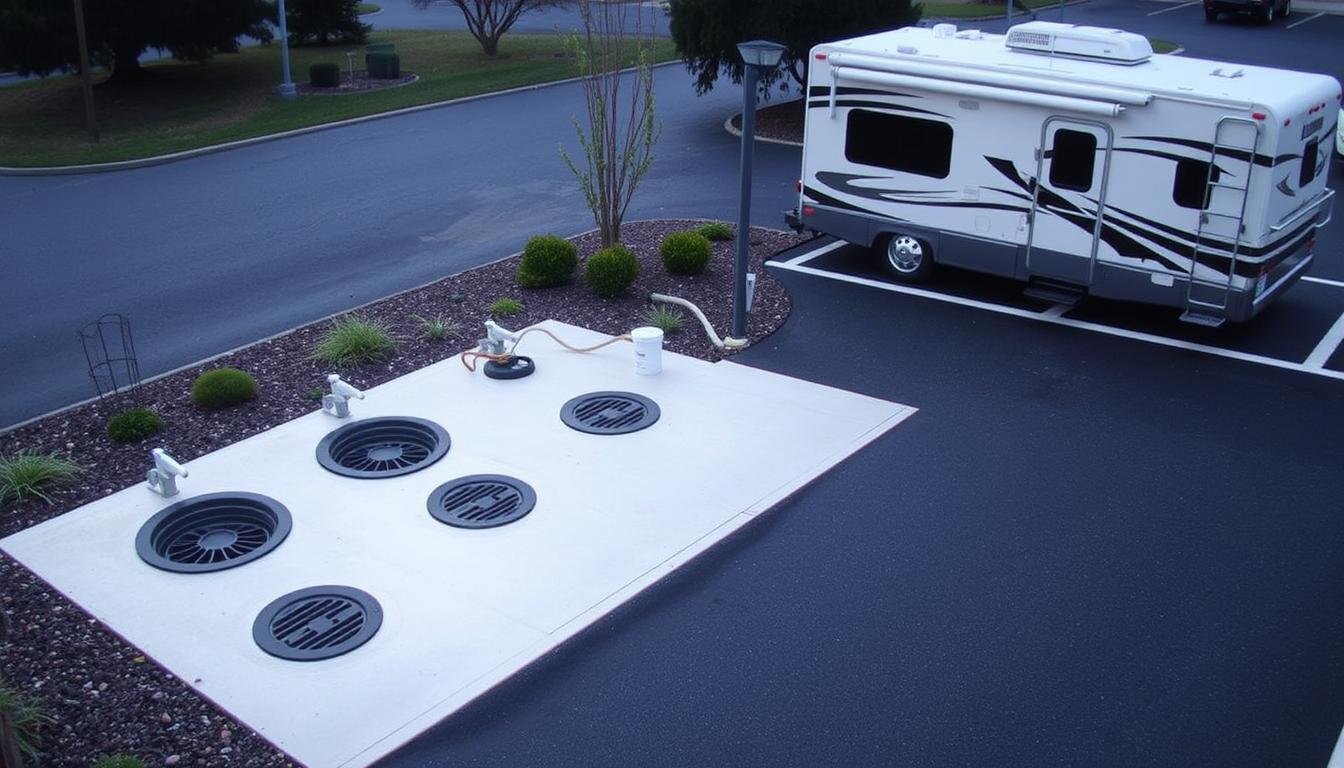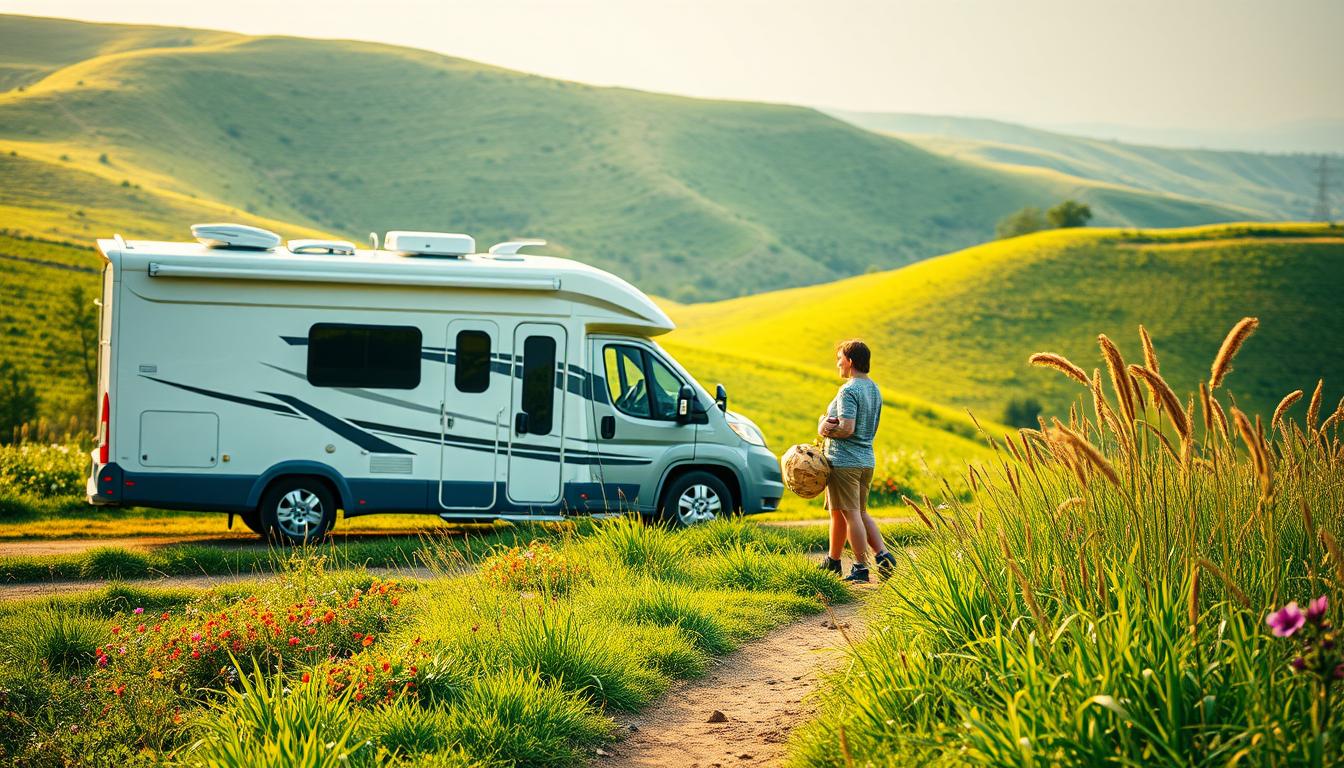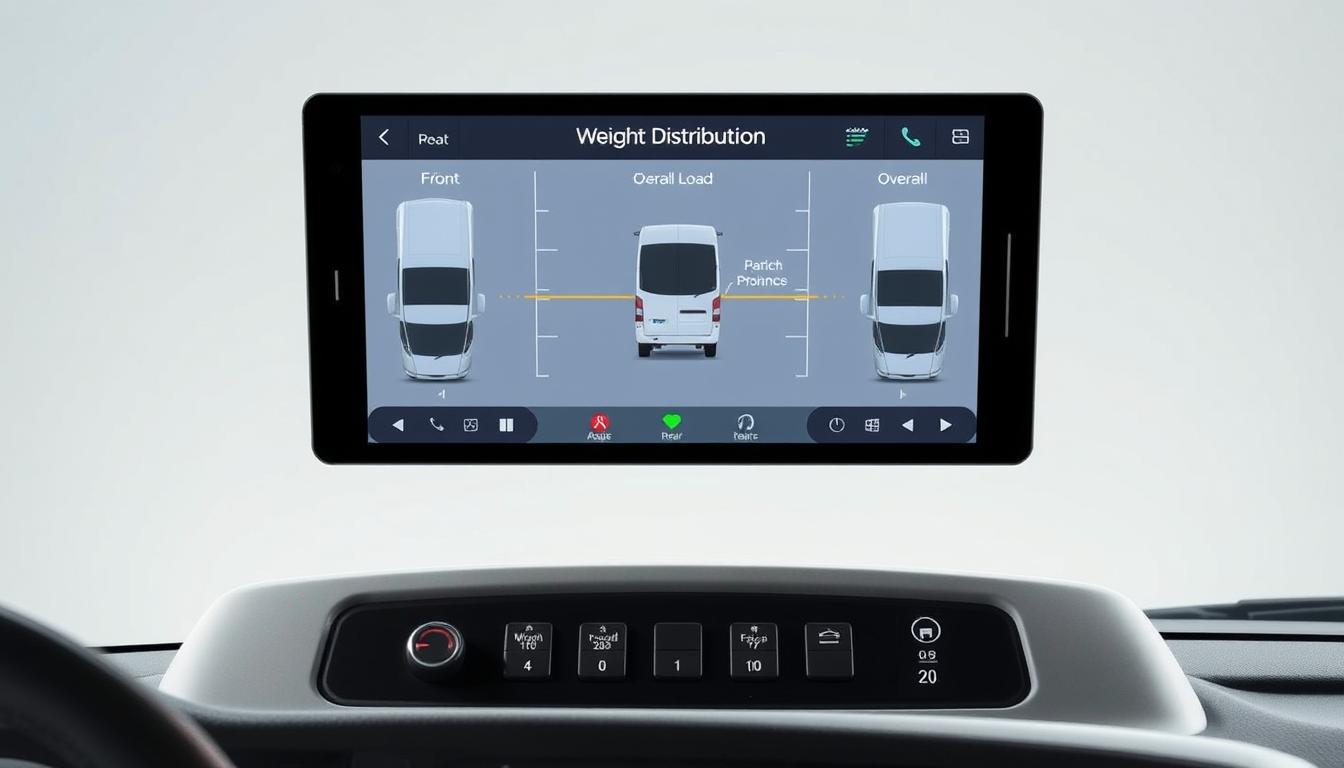Monitoring Disposal Stations for Waste in Class C Motorhomes
Ever thought about what happens to your Class C motorhome’s waste on the road? With more people owning RVs, knowing how to use RV waste disposal stations is key. It’s not just about convenience; it’s also about keeping yourself and the environment safe.
This article focuses on the best ways to manage waste in Class C motorhomes. We’ll look at why it’s important to use eco-friendly RV practices. By understanding how to monitor waste systems, RV owners can handle waste disposal in a responsible and green way.
Understanding Waste Systems in Class C Motorhomes
Class C motorhomes have waste systems that keep things clean and safe on the road. Knowing how these systems work is key to keeping your RV clean and healthy.
Black Water vs. Gray Water Systems
These motorhomes have two main tanks: the black water tank and the gray water tank. The black water tank holds waste from toilets. It’s important to handle this waste carefully when you dispose of it.
The gray water tank collects water from sinks and showers. Even though it’s cleaner, it’s still important to follow rules for disposing of it.
Many RV parks don’t let you drain gray water directly onto the ground. This is because it could pose health risks. Knowing the difference between these tanks is key to managing waste well.
The Importance of Proper Waste Management
Managing waste properly is crucial for keeping your Class C motorhome clean. If you don’t handle waste well, it can cause big problems. For example, it can lead to waste buildup in the tanks.
This buildup not only smells bad but can also mess with the sensors in the tanks. It could even cause the tanks to overflow. Understanding the waste management importance in these vehicles is essential for a safe and fun trip.
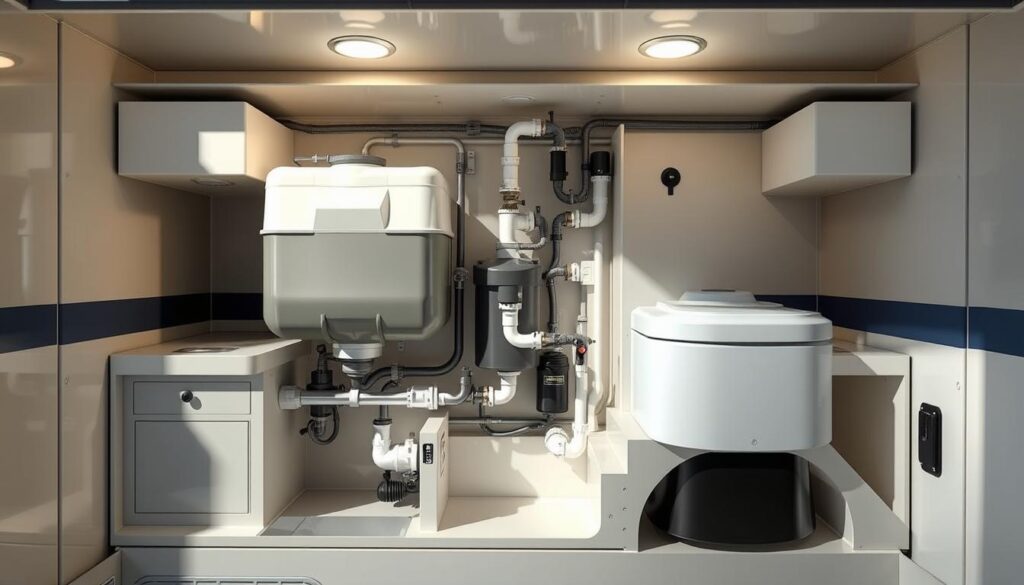
Key Components of Waste Disposal Systems
Knowing the key parts of waste disposal systems in Class C motorhomes is key for good waste management. A well-set-up system can greatly improve your RV experience. This is mainly thanks to a two-tank system and the right use of sewage hoses and waste connections.
Two-Tank System Explained
The two-tank system in Class C motorhomes keeps black water, which is sewage, separate from gray water from sinks and showers. This setup allows for more dump cycles, cutting down on the need for full dumpings. Each tank has a sewer outlet with blade-type valves for easy use and to prevent clogs.
Function of Sewage Hoses and Connections
Sewage hoses are key for moving waste to dump stations. It’s important they are strong and fit well to avoid leaks. Bayonet connectors and other fittings help manage waste flow and visibility. Keeping these parts in good shape is crucial for effective waste management in Class C motorhomes.
| Component | Function | Importance |
|---|---|---|
| Two-Tank System | Separates black and gray water | Reduces frequency of full dumpings |
| Sewage Hoses | Transfers waste to dump stations | Prevents leaks and waste contamination |
| Waste Connections | Secures hoses to tanks and dump stations | Ensures efficient waste management |
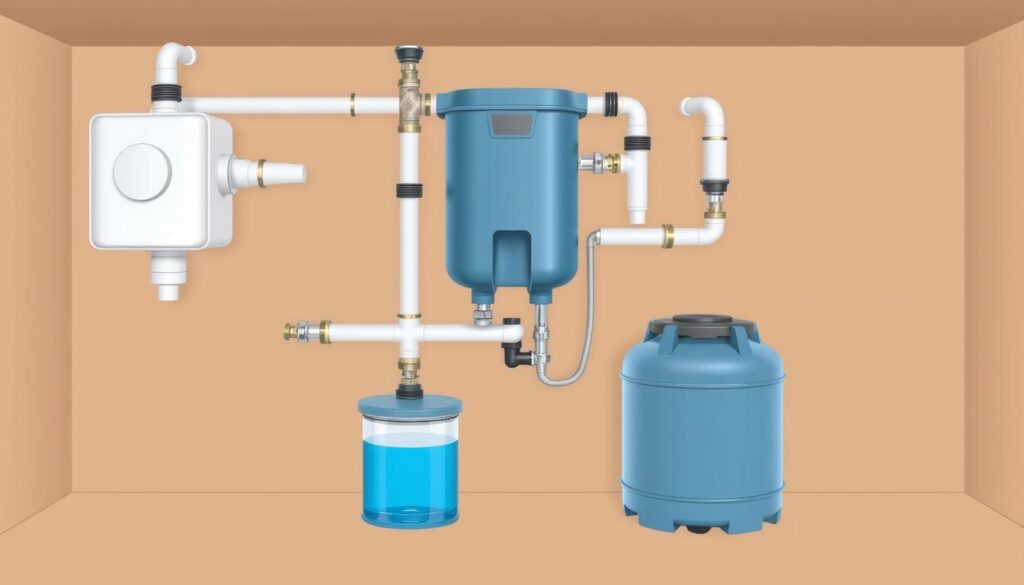
Significance of Monitoring Waste Disposal Stations
Monitoring waste disposal stations is key to managing RV waste. These stations help keep the environment and public health safe. With more people RVing, knowing about these issues is crucial.
Environmental Concerns
Monitoring waste stations helps reduce environmental harm. RV waste can overwhelm sewage systems and pollute water. This is a big risk to our ecosystems.
Authorities stress the need for proper waste handling. This prevents contamination and ensures waste is disposed of right.
Public Health Considerations
Monitoring waste stations keeps communities healthy. Proper waste disposal stops the spread of harmful pathogens. RV parks need to follow strict health rules.
Bad waste disposal can cause bad smells and dangers. It affects the lives of everyone around. So, it’s important to watch waste stations closely.
Best Practices for Waste Disposal in Class C Motorhomes
Proper waste disposal is key for keeping things clean and safe in Class C motorhomes. RV owners need the right tools and a clear plan for emptying tanks.
Essential Equipment for Waste Management
Getting the right waste management gear is the first step. You’ll need:
- Latex gloves to protect your hands during the waste handling process.
- A clearly marked black tank water hose to avoid cross-contamination with fresh water supplies.
- A sturdy sewer hose designed for secure connections and durability.
- Sanitizing cleaners to ensure cleanliness post-disposal.
This equipment helps remove waste safely and keeps things clean.
Step-by-Step Guide for Emptying Black and Gray Tanks
Using a good tank emptying guide makes the process easier and safer. Start by making sure all connections are right:
- Always dump the black tank first to remove solids effectively.
- Then, empty the gray tank to rinse the hoses.
- Close the valves carefully to prevent leaks.
- After disposing of waste, clean the hoses well with a sanitizing solution.
This method keeps things sanitary and follows the best waste disposal practices.
Legal Regulations Surrounding Waste Disposal
Every RV owner needs to know the laws about waste disposal. These laws change from state to state. They make sure waste is handled right, keeping our environment and health safe. Each state has its own rules for dumping black and gray water from RVs.
State-Specific Guidelines
States have their own ways to handle waste. Some might need RV owners to use special dumping stations. It’s key for owners to learn these rules to stay out of trouble. Knowing the right steps helps keep our communities healthy.
Impact of Non-Compliance on RV Owners
Not following waste disposal laws can cause big problems for RV owners. They might get fined, banned from RV parks, or even sued. Also, bad waste disposal can harm the environment and health. Following the rules keeps everyone safe and our places nice.
Monitoring Waste Disposal Stations for Class C Motorhomes
New technologies are changing how RV owners handle waste. Advanced RV waste monitoring tools help parks manage waste better. Innovations like flow meters and automated sampling devices make oversight more efficient.
Technology and Innovations in Monitoring
New sensor systems in waste disposal track important data. They monitor tank flow and levels, helping parks manage space. These systems make operations more efficient and help the environment.
Using Digital Sensor Systems for Efficiency
Digital sensors give RV users real-time tank level data. This prevents overflows and ensures safe waste management. The SeeLevel system is a great example, offering accurate readings. Adopting these technologies improves safety and promotes responsible waste management.
Choosing the Right Disposal Station
Finding the right disposal station is key for a great RV trip. Planning well can make managing waste easier. Look at dump stations based on certain criteria to get the best service on your journey.
Criteria for Evaluating Dump Stations
When checking out dump stations, keep these points in mind:
- Ease of Access: Make sure the site is easy for big RVs to get into.
- Cleanliness: The station should be clean to keep things hygienic.
- Facility Conditions: The waste disposal equipment should work well.
- Amenities Provided: Look for nearby restrooms and water.
- Proximity: Pick stations close to your campsite for easy access.
Reviewing Amenities and Facilities at RV Parks
RV park amenities can really make your trip better. Good facilities can add to your comfort. Check these out when looking at RV parks:
- Shower Facilities: Clean showers make your stay more comfortable.
- Laundry Services: Laundry on site saves you time on long trips.
- Kitchen Areas: Community kitchens are great for meeting people and saving time.
- Waste Disposal Facilities: Clean and easy-to-use disposal stations are essential.
Common Challenges with Waste Disposal
RV waste disposal can be tricky for motorhome owners. Knowing how to handle these issues makes your travels better and keeps your waste systems healthy.
Dealing with Blockages and Clogs
Clogs and blockages are common problems in RV waste disposal. They can happen if you don’t manage waste right or if you don’t keep your tanks in good shape. These issues can cause your RV to stop working and make bad smells.
Regular checks on your waste system and using the right flushing methods help. Also, using your tanks correctly can lower the chance of these problems.
Managing Odor Control During Disposal
Keeping smells down is key for a good camping trip. Keeping your tanks filled with water and using special odor control products helps a lot. Flushing your tanks after emptying and making sure there’s good air flow also helps.
There are resources, like this link, to help find places to dump waste properly.
Tips for Maintaining Waste Systems
Keeping your RV waste system in good shape is key for a smooth trip. Regular maintenance can make your tanks and parts last longer. Cleaning well helps your system work right and keeps bad smells away.
Regular Cleaning and Maintenance Routines
Checking tanks and hoses often is a must for RV owners. Cleaning regularly stops buildup and keeps your system working. Using flushing attachments helps clean the tanks inside. Setting up a schedule for these tasks can stop problems like clogs or leaks.
Using Chemical Additives Wisely
Chemical additives can help break down waste and control smells in RVs. But, it’s important to use them as the maker says to avoid tank problems. Choosing eco-friendly options helps keep the environment safe while keeping your system clean.
Eco-Friendly Practices for Waste Management
Using eco-friendly RV waste management is key to reducing our environmental impact. By adopting sustainable practices, we protect our planet for the future. It’s important for RV owners to know how their waste choices affect the environment.
Importance of Sustainable Practices
Using sustainable RV waste disposal methods is crucial for the environment. Choosing biodegradable products and following local waste rules are good steps. These actions help prevent pollution and make RVing more eco-friendly.
Challenges with Conventional Waste Disposal Methods
Traditional waste disposal methods often harm the environment. Untreated waste can pollute local ecosystems and threaten health. RV owners need to understand these issues to adopt better waste management.
Future of Waste Management in RVing
The RV waste management world is changing fast. New technologies are making it better and greener. These changes are driven by a need for easier and more efficient waste handling. Thanks to these innovations, RVers can manage waste like never before.
Emerging Trends in Waste Disposal Technologies
New trends in waste disposal are exciting. Mobile apps will soon show where to dump waste, making it easier to find places. Smart sensors in tanks will also change how we deal with waste. They’ll warn us when tanks are full, preventing spills.
There’s also a move towards smart and green solutions. RV makers are using eco-friendly materials in waste systems. RV parks are starting to recycle more, helping the planet.
| Innovation | Description | Benefits |
|---|---|---|
| Mobile Apps | Applications to locate nearby disposal stations and ensure efficient waste management. | Increased convenience and reduced downtime for RV users. |
| Smart Sensors | Devices that monitor tank levels and alert users when tanks are full. | Prevents overflow and enhances sanitation management. |
| Biodegradable Materials | Use of eco-friendly products in waste systems. | Reduces environmental impact and promotes sustainability. |
These new ideas in RV sanitation are great for everyone. They make RVing better and help the environment. As RVers care more about nature, these tech advances will lead to a cleaner future for all.
Conclusion
Monitoring waste disposal stations is key for keeping Class C motorhomes clean. As owners take on more environmental duties, knowing how to manage waste is vital. This summary shows why following best RV waste practices is important. It keeps us clean and protects nature.
Also, new tech in waste monitoring makes RV trips better. By keeping up with the latest and using the right disposal methods, we can lessen our environmental footprint. This focus on green practices will help make RVing more sustainable for everyone.
Staying committed to good waste management in Class C motorhomes leads to better habits. By learning about the systems and using the right tools, RV owners help keep our environment clean. This makes RVing a cleaner, more responsible activity for all.
FAQ
What is the difference between black water and gray water systems in Class C motorhomes?
Black water systems hold waste from toilets. Gray water systems collect water from sinks and showers. Knowing the difference is key for proper waste disposal and following rules.
Why is proper waste management important for RV owners?
It keeps things clean, prevents bad smells, and keeps you healthy. Bad waste handling can cause blockages and health risks.
How does the two-tank system work in Class C motorhomes?
It separates black and gray water. This means you can dump waste more often. Each tank connects to a sewer outlet with special valves.
What equipment is essential for effective waste management in RVs?
You’ll need gloves, a black tank hose, a strong sewer hose, and cleaners. These help keep things clean and safe.
What are the environmental concerns related to RV waste disposal?
RV waste can pollute water sources. It’s important to watch how waste is handled to protect the environment.
What are the best practices for emptying black and gray tanks?
Dump the black tank first to get rid of solids. Then, empty the gray tank. Always connect properly and clean hoses after use.
How do state-specific guidelines affect waste disposal for RV owners?
Rules vary by state. For example, Texas has strict rules to protect the environment. Following these rules is important for safety and health.
What impact can non-compliance have on RV owners?
Breaking rules can lead to fines and legal trouble. It can also harm your health and reputation.
How can technology improve waste monitoring in RV parks?
New tools like flow meters help track waste. This makes waste management better and ensures rules are followed.
What should I look for when choosing a dump station?
Look for easy access, cleanliness, and amenities like restrooms. It should also be close to your campsite.
What are common causes of clogs or blockages in waste systems?
Clogs come from bad waste handling and not keeping up with maintenance. Regular checks and proper use can prevent problems.
How can I manage odor control during waste disposal?
Keep tank levels right and use eco-friendly products. Flushing regularly and good ventilation also help.
Why is regular cleaning and maintenance important for waste systems?
Cleaning regularly stops buildup and keeps systems working well. Using flushing attachments helps clean tanks better.
How should I use chemical additives in waste management?
Chemicals can break down waste and control smells. But use them carefully to protect the environment. Always follow the instructions.
What are the benefits of eco-friendly practices for waste management?
Using green waste management helps the environment. It promotes a healthier world for everyone.
What emerging trends are shaping the future of waste disposal technologies?
New tech like apps for finding dump stations and smart sensors are changing waste disposal. They make it easier and more efficient for RVers.
